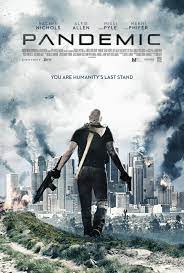
PANDEMIC
US, 2016, 91 minutes, Colour.
Rachel Nichols, Alfie Allen, Missi Pyle, Mekhi Pfeiffer, Paul Guilfoyle, Pat Healy.
Directed by John Suits.
This is not a pandemic film in the vein of Outbreak or Contagion, nor going back to the Spanish flu of the 20th century – and not in the vein of the covert 19 pandemic of the 2020 is. Rather, it is a variation on the zombie theme.
Los Angeles, 2017, the very near future from the time of the film’s release. There is mention of New York having succumbed to the pandemic. There are various headquarters in Los Angeles for the rescuing of survivors, for interning victims, various levels for studying the pandemic and its effect on the human brain, turning the victims into zombies – and, ultimately, the shooting and disposal of the worst cases. The film opens with a tour of the centre, led by hardened doctor, Paul Guilfoyle, introducing a doctor who has come from New York, Rachel Nichols. She is to command a special expedition of rescue, travelling in a bus, a former convict as driver (Alfie Allen from Game of Thrones), a navigator (Missi Pyle), and a guard who has lost his wife and is angry, symbolically named Gonna, Mekhi Pfeiffer.
The action takes place over the day, giving the opportunity to show vistas of Los Angeles, hordes of the living dead, the savagery towards each other, the threats to those not infected, many violent sequences. The group is interrupted on its mission, an attempt to save a survivor which turns into a trap to ambush the crew. When they arrive at their destination, there has been mayhem but some provisions for their survival. However, there is an attack.
At this point, there is a surprising revelation, that the doctor is not a doctor, but has taken her place and card, wanting to come to Los Angeles to rescue her husband and daughter. She confides this to the navigator who is willing to help her. The driver, who has disappeared, suddenly returns, but has been wounded and possibly infected. The rest of the film is the driving of the bus to a centre with survivors and a doctor, the doctor there recognising that the central character is an imposter, not letting them into the centre. The driver, knowing that the doctor was an imposter, agrees to help her rescue her daughter, their driving to the house, the mother finding the daughter, her husband dead in the boot of the car, the driver helping, wounded, dying. The mother desperately drives the daughter to the centre – but is deemed infected, not allowed to enter, the daughter rescued, the mother dying outside.
Many audiences have found the directing style and camera work offputting, a great deal of subjective camera work, a lot of the camera shaking, a desire for immediacy but not always persuasive.